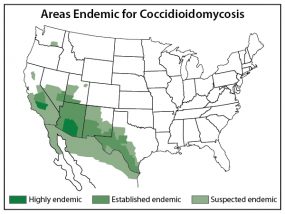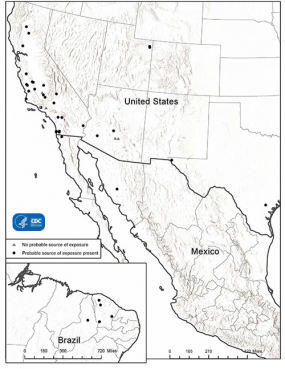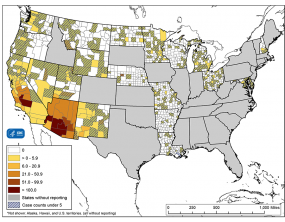Valley Fever Maps
The fungus that causes Valley fever lives in the soil in the southwestern United States, south-central Washington State, and parts of Mexico and Central and South America. These maps show:
- the approximate areas where we know or suspect the fungus lives,
- places where Valley fever outbreaks have happened, and
- cases of Valley fever detected by public health surveillance.
Scientists are still learning more about where the fungus that causes Valley fever can be found.
Approximate Areas With Valley Fever Fungus
This map shows the approximate areas in the United States and Mexico where we know or suspect the fungus that causes Valley fever lives. These are considered endemic areas for Coccidioides, the fungus that causes Valley fever.1–6 Much of what is known about where the fungus lives in the southwestern United States is based on skin testing studies performed in the late 1940s and early 1950s.2 The map also shows the locations of several outbreaks and locations of Valley fever cases acquired outside of the areas identified by those studies. Coccidioides might also live in similar areas with hot, dry climates that are not shaded on the map.
Valley Fever Outbreaks
Most cases of Valley fever are not part of an outbreak. However, Valley fever outbreaks linked to a common source do occasionally occur, particularly after events that disturb large amounts of soil. This map shows the locations of 40 Valley fever outbreaks that happened during 1940–2015.7 Some of these outbreaks happened in places where scientists did not expect the fungus to live. Investigating Valley fever outbreaks helps public health officials understand:
- Where the fungus lives,
- Activities that may make someone more likely to get Valley fever, and
- Groups of people more likely to get Valley fever
Surveillance for Valley Fever Cases
In certain states, health departments collect information about cases of Valley fever and then send the information to CDC through the National Notifiable Diseases Surveillance System (NNDSS). This map shows the average incidence of reported Valley fever per 100,000 people, by county, during 2010–2015. The rates in counties with fewer than five reported Valley fever cases, indicated by cross-hatching, might not be reliable. On this map, cases of Valley fever are classified according to people’s county of residence, which may not be where they acquired the infection. Cases in areas outside of regions where the fungus Coccidioides is believed to live are likely associated with travel to those disease-endemic areas.
References
- Marsden-Haug N, Goldoft M, Ralston C, Limaye AP, Chua J, Hill H, et al. Coccidioidomycosis acquired in Washington State. Clin Infect Dis. 2013 Mar;56(6):847-50.
- Edwards PQ, Palmer CE. Prevalence of sensitivity to coccidioidin, with special reference to specific and nonspecific reactions to coccidioidin and to histoplasmin. Diseases of the chest. 1957 Jan;31(1):35-60.
- Werner SB, Pappagianis D. Coccidioidomycosis in northern California. An outbreak among archeology students near Red Bluff. California Med. 1973 Sep;119(3):16-20.
- Werner SB, Pappagianis D, Heindl I, Mickel A. An epidemic of coccidioidomycosis among archeology students in northern California. N Engl J Med. 1972 Mar 9;286(10):507-12.
- Petersen LR, Marshall SL, Barton-Dickson C, Hajjeh RA, Lindsley MD, Warnock DW, et al. Coccidioidomycosis among workers at an archeological site, northeastern Utah. Emerg Infect Dis. 2004 Apr;10(4):637-42.
- Hector RF, Laniado-Laborin R. Coccidioidomycosis–a fungal disease of the Americas. PLOS Med. 2005 Jan;2(1):e2.
- Freedman M, Jackson BR, McCotter O, Benedict K. Coccidioidomycosis outbreaks, United States and worldwide, 1940-2015. Emerg Infect Dis. 2018 Mar;24(3):417-23.
- Page last reviewed: August 6, 2018
- Page last updated: August 6, 2018
- Content source:


 ShareCompartir
ShareCompartir


